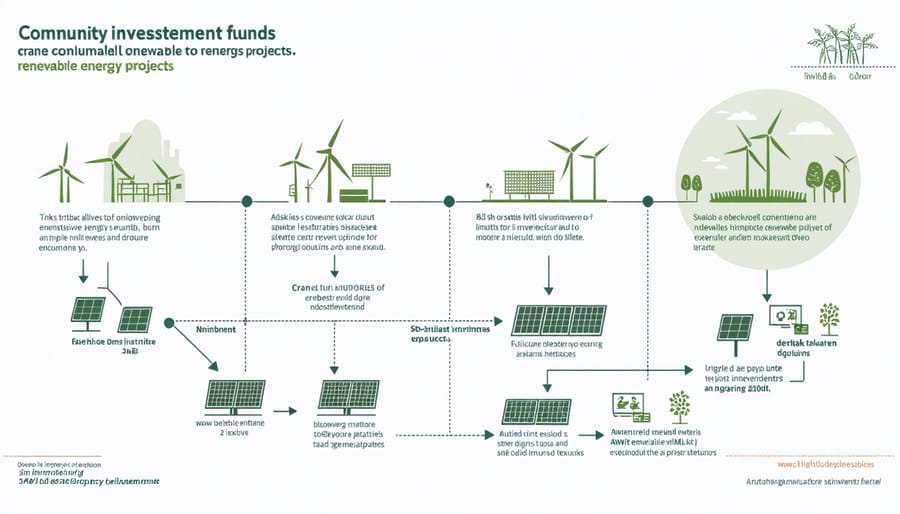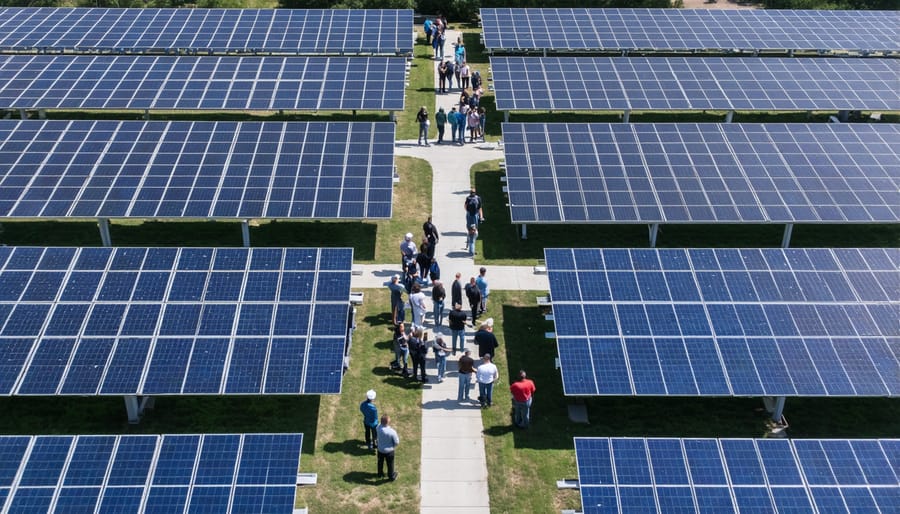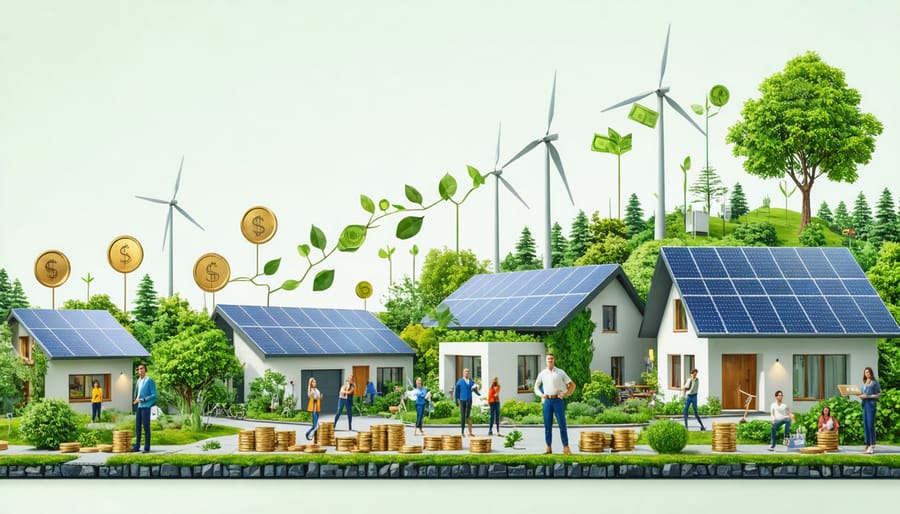Australia’s green finance revolution is transforming the renewable energy landscape, creating unprecedented opportunities for communities and investors alike. With global sustainable investment reaching $35.3 trillion in 2020, green energy financing has evolved from a niche market into a mainstream investment powerhouse. Local councils, businesses, and community groups across Australia are now leveraging innovative funding mechanisms—from green bonds to peer-to-peer lending platforms—to accelerate their transition to renewable energy.
The convergence of declining renewable technology costs, supportive government policies, and growing environmental awareness has created a perfect storm for green energy investment. Forward-thinking organizations are tapping into this momentum, utilizing creative financing solutions that not only fund sustainable projects but also generate attractive returns while contributing to Australia’s ambitious climate goals.
This surge in green financing options represents more than just an environmental imperative—it’s a compelling business opportunity that’s reshaping Australia’s energy future. Whether you’re a small community group seeking to fund a solar installation or a large corporation exploring sustainable investment opportunities, understanding the evolving landscape of green energy financing is crucial for success in today’s rapidly changing market.
The Power of Community Green Energy Financing
What Makes Community Financing Different
Community financing for green energy projects stands apart from traditional funding models through its unique collaborative approach and shared ownership structure. Unlike conventional financing where individual investors or institutions hold complete control, community-based models distribute both benefits and responsibilities among local stakeholders.
What truly sets this approach apart is its ability to leverage collective resources while keeping benefits within the community. Local residents can invest amounts as small as a few hundred dollars, making renewable energy projects more accessible to everyday Australians. This democratic approach to funding has been particularly successful in regional communities, where smart contracts for renewable energy are increasingly facilitating transparent and efficient project management.
The model also creates a stronger sense of project ownership and community engagement. When locals have a financial stake in renewable energy initiatives, they’re more likely to support and maintain them long-term. This leads to higher project success rates and more sustainable outcomes compared to externally funded ventures.
Additionally, community financing often results in faster project approval processes, as local support tends to streamline planning permissions and reduce potential opposition to new energy installations.

Benefits for Local Communities
Green energy financing brings substantial economic and social benefits to local communities, creating a ripple effect of positive change. When communities invest in renewable energy projects, they often experience significant job creation across various sectors, from installation and maintenance to project management and consulting roles.
Local businesses benefit from increased economic activity, as green energy projects typically prioritize local suppliers and contractors. For instance, the Hepburn Wind Farm in Victoria has generated over $8 million in local economic benefits since its inception, demonstrating how community-owned renewable projects can boost regional economies.
These initiatives also help reduce energy costs for residents and businesses alike. Communities that implement solar gardens or wind farms often see decreased electricity bills, with savings redirected back into the local economy. Additionally, participating communities build valuable technical expertise and develop new skill sets among their workforce.
The social fabric of communities strengthens through collaborative decision-making and shared ownership of green energy projects. Many Australian towns have reported increased community engagement and pride in their sustainable achievements, fostering a stronger sense of local identity and environmental stewardship.
Successful Community Energy Models in Australia

Solar Gardens and Community Solar Farms
Australia’s community solar initiatives have transformed the way neighbourhoods access renewable energy, with several groundbreaking projects leading the way. The Majura Valley Solar Farm in the ACT stands as a shining example, where 600 residents pooled their resources to create a 1.2MW solar installation that now powers over 250 homes. This successful venture demonstrated how shared investment could make solar energy accessible to renters and apartment dwellers who previously couldn’t install their own panels.
In regional Victoria, the Bendigo Sustainability Group pioneered a unique model where community members purchase virtual plots in a solar garden, receiving credits on their electricity bills proportional to their investment. The project has since inspired similar initiatives across the country, including several innovative blockchain-enabled solar projects that ensure transparent management of energy credits.
The Sydney Solar Villages project showcases another successful approach, where five neighbouring suburbs collaborated to create interconnected solar gardens on available public land. This initiative not only generates clean energy but also provides educational opportunities and community engagement activities, strengthening local bonds while reducing carbon emissions.
These community solar farms typically operate through a cooperative structure, where members can invest as little as $500 to participate. The Byron Bay Community Solar initiative demonstrates how this model can work effectively, generating both environmental and financial returns for its 350 members while supporting local energy independence.
The success of these projects has caught the attention of local councils nationwide, with many now offering matching grants and administrative support to help establish new community solar gardens, making green energy increasingly accessible to all Australians.
Bioenergy Cooperatives
Across rural Australia, bioenergy cooperatives are emerging as powerful examples of community-driven renewable energy initiatives. The Mount Alexander Bioenergy Project in Victoria stands as a shining example, where local farmers and residents pooled resources to create a facility converting agricultural waste into clean energy. This cooperative now powers over 500 homes while providing additional income for participating farmers.
In the Northern Rivers region of New South Wales, the Richmond Valley Bioenergy Alliance demonstrates how community funding can transform waste management challenges into renewable energy opportunities. Their innovative model combines investments from local businesses, council support, and community shareholders to operate a biogas facility processing food waste and agricultural residues.
The Cowra Biomass Project showcases the potential of smaller communities to achieve energy independence. Through a combination of crowdfunding, government grants, and local business investments, this cooperative transformed organic waste from nearby farms and food processors into biogas, creating local jobs and reducing waste management costs by 40%.
These success stories share common elements: strong community engagement, transparent governance structures, and clear benefit-sharing arrangements. Typically, community members can invest as little as $500 to become shareholders, receiving both financial returns and reduced energy costs. The cooperative model ensures decisions benefit the entire community, not just individual investors.
Most successful bioenergy cooperatives partner with local councils and agricultural businesses to secure reliable feedstock supplies. They also implement educational programs to help community members understand the technology and benefits of bioenergy, building lasting support for these sustainable initiatives.
How to Start a Community Green Energy Project

Building Community Support
Building community support for green energy projects requires a strategic blend of engagement, education, and collaboration. In communities across Australia, successful renewable energy initiatives often start with grassroots movements that bring together diverse stakeholders.
Local councils and community groups can organize information sessions and workshops to educate residents about the benefits of green energy projects. These events provide platforms for addressing concerns and showcasing potential economic advantages, such as reduced energy costs and job creation opportunities.
Establishing green energy working groups that include representatives from different sectors of the community helps ensure diverse perspectives are considered. These groups can include local business owners, environmental advocates, indigenous leaders, and residents, creating a more inclusive approach to project development.
Social media campaigns and local media engagement play crucial roles in building awareness and support. Sharing success stories from similar communities, particularly those in regional Australia, can help demonstrate the tangible benefits of green energy initiatives.
Creating partnerships with local schools and educational institutions can foster long-term community buy-in. Students involved in renewable energy projects often become enthusiastic advocates, inspiring their families and broader community networks to support sustainable initiatives.
Regular community feedback sessions and transparent communication about project progress help maintain trust and momentum. This approach has proven successful in numerous Australian communities, where renewable energy projects now operate with strong local support and ongoing community involvement.
Legal and Financial Frameworks
Australia’s green energy financing landscape is shaped by a robust framework of federal and state regulations that guide renewable energy investments. The Renewable Energy Target (RET) scheme remains a cornerstone policy, creating a market-based system that encourages investment in renewable energy projects through tradeable certificates.
The Clean Energy Finance Corporation (CEFC) plays a pivotal role by offering various sustainable financing structures tailored to different project scales. These include direct investments, co-financing arrangements, and innovative funding mechanisms that help bridge the gap between traditional lending and green energy initiatives.
State governments have implemented complementary frameworks, such as Victoria’s Renewable Energy Action Plan and New South Wales’ Electricity Infrastructure Roadmap, which provide additional financial incentives and regulatory support. These frameworks often include feed-in tariffs, grants, and tax incentives that make green energy projects more financially viable.
For project developers, understanding these frameworks is crucial. Key considerations include environmental impact assessments, planning permits, and grid connection requirements. Financial structures typically involve a combination of equity investment, debt financing, and potentially government support, with many projects adopting hybrid models that spread risk and maximize returns.
The regulatory landscape continues to evolve, with increasing emphasis on Environmental, Social, and Governance (ESG) criteria in investment decisions. This evolution is creating new opportunities for innovative financing solutions while ensuring projects maintain high environmental and social standards.
Available Government Support
The Australian government offers substantial support for green energy initiatives through various programs and incentives. The Renewable Energy Target (RET) scheme remains one of the cornerstone policies, providing financial incentives for both small and large-scale renewable energy projects. Under this scheme, businesses and households can access Small-scale Technology Certificates (STCs) when installing solar panels, wind turbines, or other eligible systems.
The Clean Energy Finance Corporation (CEFC) plays a crucial role by providing competitive financing options for renewable energy projects. They offer loans with favorable terms and have committed billions of dollars to support Australia’s transition to sustainable energy. Local councils and state governments also provide additional rebates and incentives, which vary by region but can significantly reduce initial investment costs.
For businesses, the instant asset write-off scheme can be applied to green energy installations, offering immediate tax benefits. The Australian Renewable Energy Agency (ARENA) provides grants and funding for innovative renewable energy projects, particularly focusing on emerging technologies and research initiatives.
Community groups can access specific funding through the Community Energy Efficiency Program (CEEP) and various state-based initiatives. These programs often cover up to 50% of project costs and provide technical support throughout implementation. New grant opportunities are regularly announced, making it essential to stay connected with local energy networks and government websites for the latest funding rounds.
Overcoming Common Challenges
While green energy financing offers tremendous opportunities, communities often face several hurdles when implementing renewable energy projects. The good news is that these challenges can be overcome with the right strategies and support.
One common obstacle is the initial capital requirement. Many communities struggle to raise sufficient funds for project startup. Successful projects have addressed this through innovative approaches like crowd-funding platforms, cooperative models, and partnerships with local credit unions. The Clean Energy Finance Corporation has been instrumental in bridging funding gaps through matched investment schemes.
Technical expertise can be another stumbling block. Communities may lack the specialized knowledge needed for project planning and implementation. This challenge can be addressed by partnering with experienced renewable energy consultants or forming relationships with universities and technical institutions. Many regional renewable energy hubs now offer mentorship programs and technical support.
Regulatory complexity often intimidates community groups. Navigating permits, grid connections, and compliance requirements can seem overwhelming. However, organizations like the Australian Community Energy Network provide valuable guidance and resources to help communities understand and manage these processes effectively.
Community engagement and maintaining long-term commitment present ongoing challenges. Successful projects have overcome these by establishing clear communication channels, celebrating small wins, and ensuring transparent governance structures. Regular community forums and updates help maintain momentum and trust.
Risk management concerns can deter potential investors. Smart projects address this through comprehensive insurance coverage, professional feasibility studies, and diversified funding sources. Many communities now use staged implementation approaches to demonstrate viability before scaling up.
These challenges, while real, shouldn’t discourage communities from pursuing green energy initiatives. With proper planning and support, they’re entirely manageable stepping stones toward sustainable energy independence.
Community financing for sustainable energy represents a powerful pathway toward Australia’s renewable energy future. As we’ve seen through numerous successful projects across the country, when communities come together to invest in green energy initiatives, they create lasting environmental and economic benefits for all stakeholders. From solar gardens in regional towns to wind farms backed by local investors, these projects demonstrate that sustainable energy financing isn’t just about returns – it’s about building resilient, self-sufficient communities.
The momentum behind community-funded green energy projects continues to grow, offering an inspiring model for future developments. By participating in these initiatives, everyday Australians can become active contributors to our nation’s energy transition while securing their financial future. The time to act is now, with numerous opportunities available for communities to start their own sustainable energy projects.
Whether you’re an individual investor, community leader, or local business owner, you can play a vital role in this transformation. Consider joining or initiating a community energy project in your area, attending local sustainability meetings, or exploring investment opportunities in existing green energy initiatives. Together, we can create a cleaner, more sustainable energy future for generations to come.

